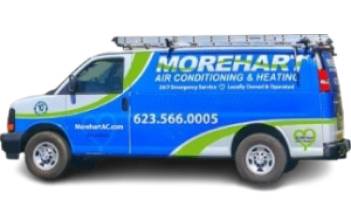Meet Brian, an HVAC technician, at Morehart Air Conditioning and Heating Company. He’ll be sharing a typical day as an HVAC technician, working in various industrial settings such as homes and commercial building like schools, hospitals, and office buildings. Stay with us as he shows us what it means to be an HVAC technician and the best parts of the job. He’ll tell us about their everyday tasks and challenges, as well as the crucial role they play in improving air quality and comfort in homes by following blueprints and specifications for proper installation and service calls.
Over to Brian. Let’s get started!
Key Highlight
- HVAC technicians play a crucial role in the installation, repair, and servicing of heating, ventilation, air conditioning, and refrigeration systems.
- They take care of every aspect of HVAC systems to ensure proper functioning and guarantee comfortable indoor environments.
- HVAC technicians, however, also experience different challenges, ranging from unforeseen situations to complex troubleshooting scenarios
- Developing trust and keeping a good relationship with the customer is a major task for an HVAC technician.
Starting the Day: Preparing for Success
As a successful HVAC technician, the morning secret has always been waking up mentally and physically prepared for the day. We do this by staying true to our morning routine. This helps us stay productive and focused on the task ahead.
Morning Routine of an HVAC Technician
After waking up, we check our work schedule for the day. We check out some outstanding tasks from the previous day. If all checkboxes are ticked, then we go ahead looking out if we have an appointment for the current day. If we do, we mark the time and set reminders an hour before the appointed time. This enables us to stay punctual.
Communicating with Customers Before Arrival
Before stepping out from our location to meet, we talk to our client. We confirm the appointment and make sure we understand the issue even better. This will help us in case there’s a need to take with us an unconventional working tool or equipment (although that’s in rare cases). With the rise of fake HVAC companies in Arizona, good communication helps build trust and rapport with our dear clients.
Gathering Tools and Equipment for the Day
Before heading out for our first job, we make sure we are fully equipped with the necessary tools for the task before us. It could be tools for installing, repairing, or even maintenance. Some of the key items we gather include:
- Toolbox: We don’t need to feel our pockets with individual tools. Most of these tools like screwdrivers, pliers, wrenches, and wire cutters are in a toolbox. We use these tools for tasks like tightening, loosing, connecting wires, or adjusting HVAC components.
- Measurement Tools: To diagnose HVAC issues, and ensure the system is properly functioning, we need measurements. We need thermometers to measure the temperature of heating and cooling components. We also use a pressure gauge, to measure the pressure and airflow in the HVAC system.
- Electrical Testing Equipment: Most HVACs are electrical appliances so we also need electrician specialized equipment like multimeters and voltage testers to test and ensure the functionality of electrical parts.
- Refrigerant Recovery Equipment: During maintenance or servicing, refrigerants can escape. We need refrigerant recovery equipment to safely recover or store refrigerant while working.
All these tools start the day with us. It’s unprofessional to leave any of these behind, they help us form our success stories, and they are that important.
On the Road: Navigating to Our First Job
Now that our tools and equipment are all set, it’s time to hit the road to our first job. An HVAC technician understands the vital role of time in their job, especially with the foreseeable future of continued use of refrigerators, heating systems, and air conditioners. According to the Bureau of Labor Statistics (BLS), HVACR technicians work mostly in homes, schools, hospitals, office buildings, or factories, making their workplace a variety of settings. So we are most likely to move around a lot.
We know that a delayed response to your call means a longer period for an individual or even worse, a family, to stay in an extremely uncomfortable environment. And we love families. So, we wouldn’t want that. We leave our location earlier enough to have enough time and to spare in traffic.
All we know is that we must get to our client’s location on time and be well prepared as part of a team, ensuring a safe and compliant work environment and the efficiency of HVAC systems. As an HVAC technician, it is important to have proper certification to improve your job security. However, there are also cons to this career path, such as the potential for long hours and physically demanding work in tight spaces.
The Heart of the Work: What We Do

The responsibility of HVAC technicians revolves around installation, repair, and servicing. And that’s the part of our job the world usually identifies us with. This is the time we apply all our skills, knowledge, and experience, and put it all to good use to produce the best results.
As we carry on with our job, we maintain an open communication where our clients can ask questions concerning their HVAC tech, and we give our piece of advice. We consider clear communication an essential duty of an HVAC technician, explaining technical problems in simple terms.
Step-by-Step Installation Process
As HVAC technicians, there are a few installation steps we always repeat when installing HVAC units. Let me provide you with a quick summary of our installation process.
- Inspection: We first have to inspect the surroundings of our client. We do this to locate the best possible location to install the unit for proper air circulation.
- Preparation: We then go ahead to clear away every obstacle around the installation site. This is because HVAC units are heavy equipment that consume a lot of space. If the unit requires ductwork, we’ll also install the necessary ductwork.
- Connecting Components: We then connect all the components of the HVAC unit. The air conditioner, the furnace, the ventilation system, and the thermostats.
- Electrical wiring: HVAC units are electrical systems and must be properly wired to ensure a safe and efficient operation. They also test to ensure the unit is running with the proper amount of voltage
- Testing and calibration: After we round up the electrical wirings, we make sure to calibrate necessary measurements like temperature and airflow.
Overcoming Challenges: Unique Situations and Solutions
Just as in every other profession, you cannot be certain of what to expect. Each day comes with its own challenges and hurdles. Today might be the day you face an entirely new problem, while tomorrow might be an easy peasy. You’ll need all your job training, practical skills, and experience to face head-on, whatever challenge that will be coming your way.
I remember once troubleshooting an HVAC unit for as long as usual that I almost gave up midway. I got to see those types of challenges pretty often as a newbie in the industry. This is why, as HVAC professionals, we need to remain resilient in the face of tough challenges in the HVAC industry, including unique situations such as new construction projects.
These challenges can range from unforeseen situations to complex troubleshooting scenarios, but the rewards and opportunities for growth in the industry often outweigh the drawbacks. The good news is that those especially tough challenges added to my experience in the HVAC industry. Because when faced with that same scenario, I get done in a jiffy.
What Is the Most Common Challenge HVAC Technicians Face?
The most common challenge we face as HVAC technicians is troubleshooting complex issues in the HVAC unit, while also providing excellent customer service. Such issues require a deep understanding of the different HVAC components and the ability to effectively communicate with clients.
We usually overcome these challenges through our experience gathered from past challenges and through the knowledge gained from our rigorous HVAC training program. However, sometimes we encounter unexpected problems that require necessary repairs, which can be time-consuming and challenging to complete.
Wrapping Up: The End of a Productive Day
Now, this is personal to me. But I’ll include it here. To make sure I’m not leaving any stone unturned, I go through my final checklist. My checklist usually includes tasks like recording service reports, updating maintenance logs, organizing equipment inventory, and so on.
The reason I love revisiting my checklist before I end my day is to ensure that I end my day fulfilled. Seeing all my checklists ticked off gives me this feeling of satisfaction and achievement. It gives me the spring force to prepare for my next day as well.
Preparing for the Next Day’s Challenges
This is something we, as HVAC technicians, don’t joke with. After the long day, we give ourselves time to rest from the long day and recharge, feeling pumped up for the next day. By doing this, we set ourselves up for success and ensure we stay at our highest level to provide the best services to our next clients.
Do You Need an HVAC Technician?
It’s the full responsibility of HVAC technicians to improve comfort and enhance well-being through the HVAC units. Over here in Arizona, Morehart Air Conditioning and Heating Company is the leading company to solve your heating and cooling needs.
If you have any HVAC needs, issues with your heat pump, refrigeration system, or energy efficiency issues, don’t hesitate to reach out to me, a certified NATE (North American Technician Excellence) and EPA technician with a successful HVAC career. I start my day and end it with your HVAC needs in mind. Reach out to me now.




